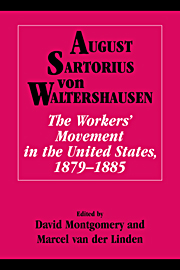Book contents
- Front Matter
- Contents
- Acknowledgments
- 1 Introduction
- 2 August Sartorius von Waltershausen (1852–1938), German Political Economy, and American Labor
- 3 The Trade Unions in the United States of America
- 4 Boycotts: A New Trade Union Weapon in the United States
- 5 Relief Funds in the United States
- 6 Bibliography of Sartorius von Waltershausen's Writings
- Index
3 - The Trade Unions in the United States of America
Published online by Cambridge University Press: 22 September 2009
- Front Matter
- Contents
- Acknowledgments
- 1 Introduction
- 2 August Sartorius von Waltershausen (1852–1938), German Political Economy, and American Labor
- 3 The Trade Unions in the United States of America
- 4 Boycotts: A New Trade Union Weapon in the United States
- 5 Relief Funds in the United States
- 6 Bibliography of Sartorius von Waltershausen's Writings
- Index
Summary
Factors Helping and Hindering the Trade Union Movement
Heinrich Semler, the eloquent analyst of North American agriculture, comments in his well-known book on overseas grain competition on the prevalence of economic and social organizations in the United States. He sees this as a major reason for its people's economic success. Ninety-nine out of every 100 Americans belong to some association or another and 95 belong to a sickness or death insurance fund, he avers. This phenomenon certainly cannot be attributed to any natural inclination by this young nation, which makes it tend toward a greater degree of socialization than other nations, since U.S. citizens not born in the country and even recent immigrants are just as enthusiastic about joining clubs, societies, and associations as the people who have lived there for generations. This trait should be seen within the context of the overall economic character of the American people. Just as this is the outcome of various natural conditions and social and political institutions, which also influence the immigrants who have started a new life in the New World, the widespread phenomenon of the associations should be seen as the outcome of the same underlying causes. It should be remembered that no more than 50 years ago even those regions now considered the most developed on the continent were characterized by the colonial conditions that still obtain in a number of states and territories today.
- Type
- Chapter
- Information
- The Workers' Movement in the United States, 1879–1885 , pp. 65 - 152Publisher: Cambridge University PressPrint publication year: 1998



